|
|
Impossible Mission
|
Name:
|
Impossible Mission |
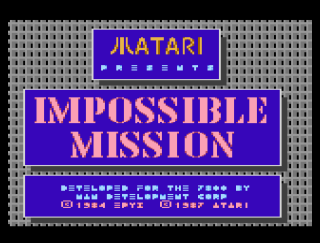 |
| Company: | Atari | |
|
Model #:
|
CX-7832 | |
|
Programmers:
|
Brian Richter & Arthur
Krewat (Computer Magic) |
|
| Year: | 1988
|
|
|
Released?
|
Yes
|
|
|
Notes:
|
The original NTSC release was impossible to beat due to a programming bug |
Port of the 1985 Epyx computer game, Impossible Mission is an
action/puzzle game where the the player plays the role of
Special Agent 007
4125 who must infiltrate the lair of the evil Professor Elvin
Atombender and stop him from breaking the code needed to launch
the country's missiles and start World War III. As a
special agent of the government you're armed with guns, armor,
bombs... just kidding, your special agent is armed only with the
ability to make really nice somersault leaps. Yep you read
that right, you only have the power of gymnastics to help you
take down an evil mad scientist. Oh, did I forget to
mention that you only have six hours to save the world?
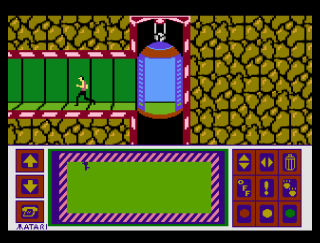
The game takes place in the underground lair of Atombender which is made up of 32 different rooms that are connected by a eight different elevators. These elevators only go to certain rooms in the complex, so making a map is important. Each room consists of a series of platforms, some of which contain lifts that can be used to get to higher platforms. These lifts can contain several different platforms and will only move until the top or bottom platform reaches the top or bottom of the level. This means that the player may need to move off and on the lifts to get to the top or bottom most platforms. Thankfully there are 'lift reset' passwords that can help with this (more on that later). Rooms also contain pieces of furniture which must be searched (searching takes several seconds) in hopes of finding punch card pieces which can be used that the central computer to solve the final puzzle. Sometimes furniture contains passwords which will allow the player to to reset lifts or snooze robots when used at a terminal, but many times they contain absolutely nothing.
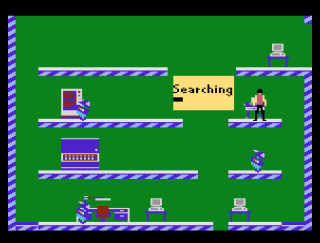
Robots also roam each room and are deadly to the touch. Robots have different personalities which are randomized upon entering the room. Sometimes a robot will simply stand there and not chase the player, some robots move back and forth in a set pattern, while others will chase the player when they see then. Robots also have the ability to shoot electric beams which will vaporize the player if hit. Robots come in two flavors, a standard roving robot that is confined to the floor it's currently on (they can't take lifts), and orbs which are much slower than the standard robot and can't fire beams but they can float around the screen (although they can't go through platforms). If a player is killed by a robot or falls down a hole 10 minutes are deducted from your six hour time limit. Due to the somewhat random nature of the game, certain pieces of furniture might be nearly impossible to search, This means that many times the player must decide if it's worth wasting lives or snoozes trying to successfully search a piece of furniture or leave it and hope that a puzzle piece wasn't hiding behind it.
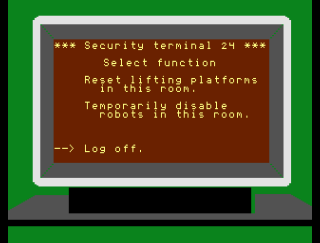
The complex also contains two Code Rooms which can be used to gain extra Robot Snooze and Life Reset passwords. To win these extra passwords the player must listen to a sequence of notes which appear as squares on a checkerboard and put them in order from low to high. While this starts out easy with only five notes, the number of notes increases by one each time. The reward is also randomized so you may only get Lift Resets when you were hoping for Robot Snoozes or vice versa. Once the player has successfully found all 32 pieces of the puzzle, they can use their Pocket Computer (press the button when not inside a room) to try and assemble the puzzle to reveal the password which will allow entry into Atombenders lair which is located in one of the 32 rooms (big door, can't miss it) where you will foil his plans. Each digit of the code consists of four punch card pieces which must be rotated and pieced together correctly by color. Once a player has figured out a digit, it will appear at the bottom of the Pocket Computer screen, so you don't have to figure them all out at once. The player may also phone a friend the agency for hints on how the pieces should be assembled. Each hint costs two minutes so be sure to get your parents permission first!
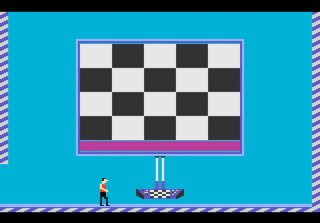
The most memorable part of Impossible Mission, and what made it so famous upon its release on the C64, was its digitized speech samples. After declaring "Stay awhile. Stay FOREVER!" upon entering his complex, Elvin constantly taunts the player with various digitized insults. The speech was amazingly clear and articulate at the time and was not made up of pieced together phoneme's as most computer speech synthesizers of the time used. Unfortunately most ports of Impossible Mission lost the cool speech samples, including the Atari 7800 version. According to the programmer, there simply wasn't any time to even attempt to add speech to the game so it was never looked into.
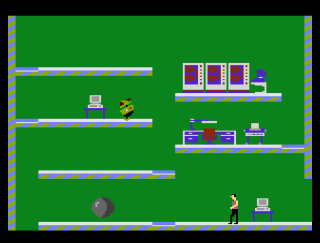
That isn't to say that the Atari 7800 version is a bad port. The graphics have been updated nicely from the original computer ports (although your character looks more like a middle aged dad rather than a secret agent), and the programmer did the best he could with the sound and music given that the 7800 didn't have a built in Pokey chip. The gameplay is nice and smooth (and fast!) but the jumping feels a little off compared to the other versions. In the 7800 version the player seems to jump further, but in a shallower arc which can make some of the precision jumps needed to win the game way more difficult than they should be. Of course there's also the little fact that the game truly is impossible to beat which puts a damper on things...
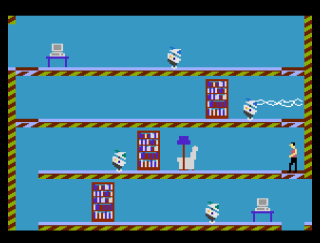
The Atari 7800 version of Impossible Mission is a fairly well known, but not for a good reason. Due to cost cutting and the minimal playtesting during the Tramiel era, a bug slipped into the released version of the game. This bug accidentally places puzzle pieces behind computer terminals instead of only behind pieces of furniture. Since computer terminals are not searchable (they only bring up a screen of options) this means that players cannot possibly get all the puzzle pieces need to win the game unless they get extremely lucky with the piece placement. The game actually hides 35 puzzle pieces yet only 32 are needed win the game, so if the three extra pieces are the ones hidden behind terminals the player may actually be able to win. The odds of this happening are quite low however and the player has no way of knowing if the layout is favorable or not until the actually play the game so its doubtful anyone actually succeeded in beating the game.
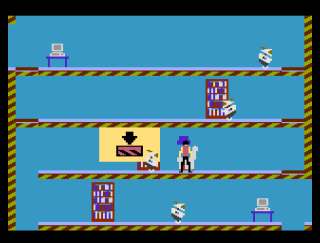
So how did a game breaking bug slip into the released version? Programmer Arthur Krewat believes that he accidentally introduced the bug after being asked to cut the game size down. Originally Impossible Mission was written to use 256Kbit static ram (this version was dated 4/25/88), but this proved to be too costly so Atari sent the game back to and asked Arthur to squeeze it down to fit into 128Kbit. In order to do this he had to rewrite the puzzle piece placement code instead of simply using the original code from the C64 version. It was during this code rewrite the he believes that the bug came into being (this version was dated 7/5/88). So why didn't Atari catch the bug? Arthur theorizes that Atari didn't retest the game (or did a very minimal amount of testing) after he sent them the new revision because they wanted the game out as soon as possible. Unfortunately for Atari, this decision would prove costly.
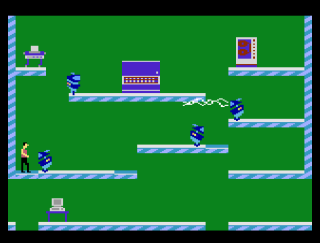
Atari realized there was a bug shortly after the
game was released and created a new revision of the game without
Arthur's input (this version was dated 8/11/89). According
to an internal memo no one had yet placed an order for the fixed
version (possibly due to low sales) and they still had the
bugged version in their inventory so It was suggested that they
should dump the bugged version into the South American market
and clear out the inventory lest they accidentally send out the
bugged version to their US distributors. Why Atari thought
that it was acceptable to sell a knowingly bugged game in the SA
market is unknown. The bug was fixed during the conversion
from NTSC to PAL so no faulty carts ever made it into PAL
territory.
| Version | Cart Text | Description |
| 4/25/88 | Original 256Kbit version | |
| 7/5/88 | Released version (with bug) | |
| 8/11/89 | Fixed version |
